A Survey of Agent-Based Modeling Practices (January 1998 to July 2008)
Journal of Artificial Societies and Social Simulation
12 (4) 9
<https://www.jasss.org/12/4/9.html>
For information about citing this article, click here
Received: 26-Nov-2008 Accepted: 22-Aug-2009 Published: 31-Oct-2009
 Abstract
Abstract
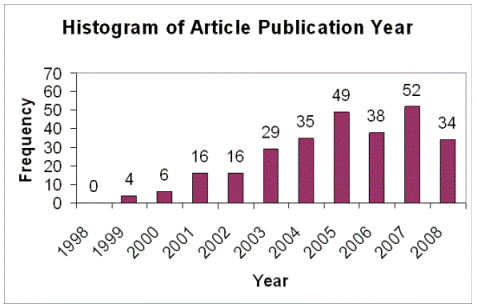
|
| Figure 1. Number of Articles per Year in the Sample |
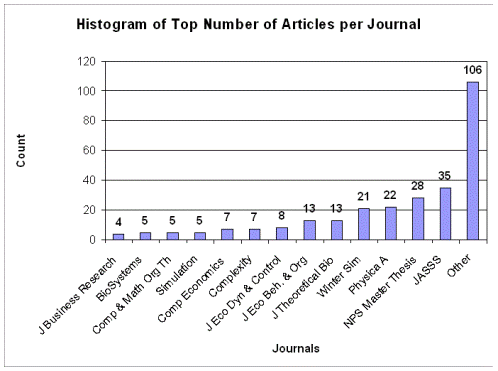
|
| Figure 2. Articles per Publication Outlet in the Sample |
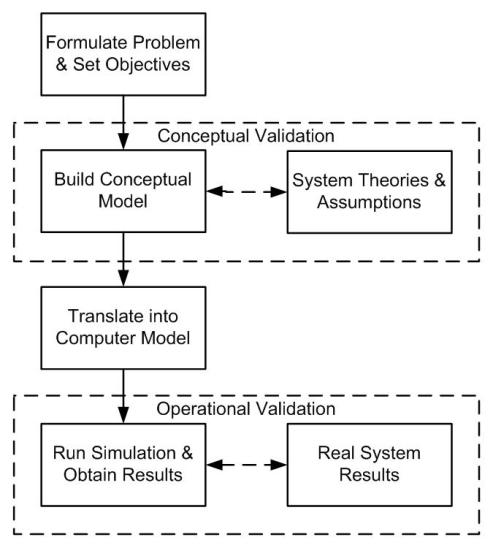
|
| Figure 3. A Simplified Simulation Development Process |
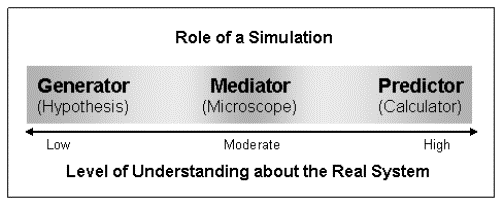
|
| Figure 4. Purpose of the Simulation |
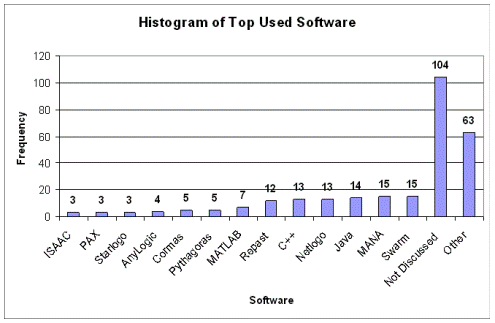
|
| Figure 5. Histogram of Top Used Software |

|
| Figure 6. Breakdown of Articles by Field |
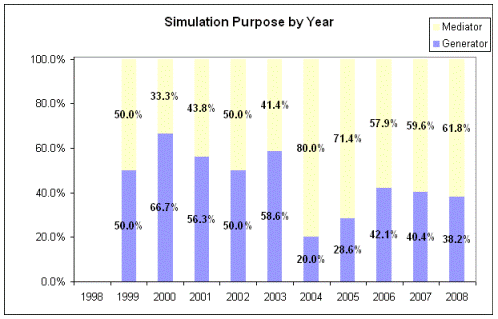
|
| Figure 7. Simulation Purpose by Year |
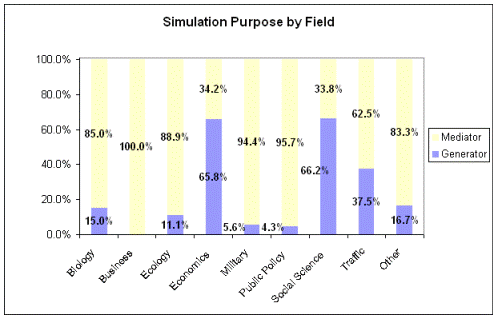
|
| Figure 8. Simulation Purpose by Field |
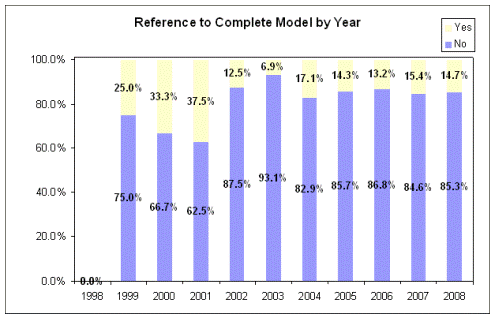
|
| Figure 9. Reference to Complete Model by Year |
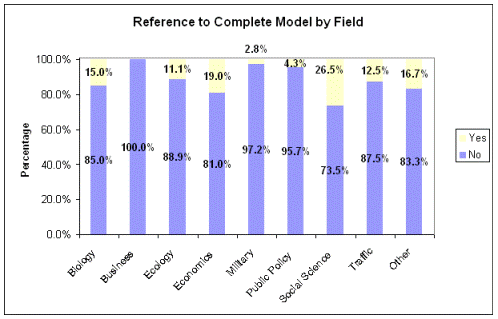
|
| Figure 10. Reference to Complete Model by Field |

|
| Figure 11. Reference to the Complete Model by Purpose |
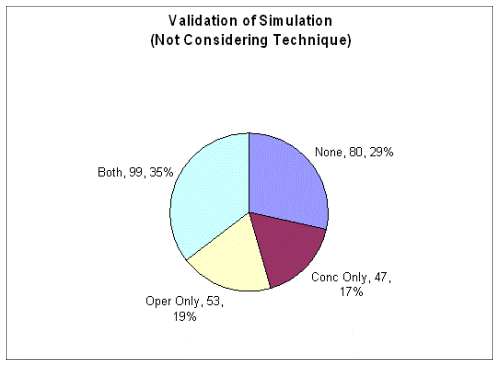
|
| Figure 12. Validation of the Simulations (Not Considering Technique) |
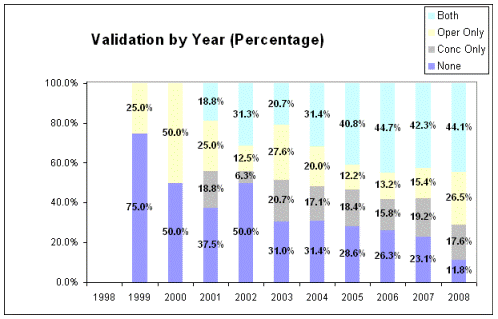
|
| Figure 13. Validation by Year |
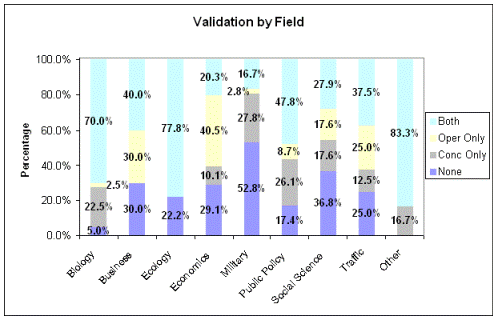
|
| Figure 14. Validation by Field of Study |

|
| Figure 15. Validation by Purpose |
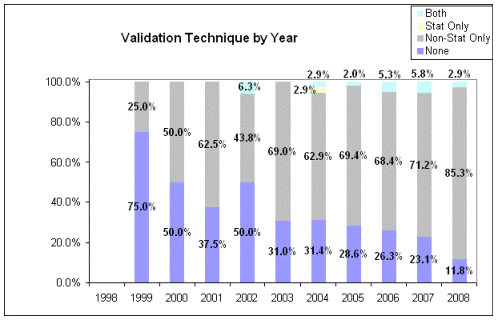
|
| Figure 16. Validation Technique by Year |
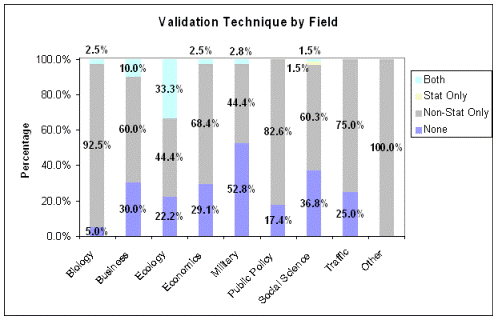
|
| Figure 17. Validation Technique by Field |

|
| Figure 18. Validation Technique by Purpose |
Agar, M. H. (2005). Agents in living color: Towards emic agent-based models. Journal of Artificial Societies and Social Simulation, 8(1) 4, https://www.jasss.org/8/1/4.html
Akaishi, J. and Arita, T. (2006). Agent-based modeling for investigating adaptivity of misperception. Systems and Computers in Japan, 37(12), 482-491.
Aktipis, C. A. (2004). Know when to walk away: Contingent movement and the evolution of cooperation. Journal of Theoretical Biology, 231, 249-260.
Alam, S. I., Meyer, R., Ziervogel, G. and Moss, S. (2007). The impact of HIV/AIDS in the conext of socioeconomic stressors: An evidence-driven approach. Journal of Artificial Societies and Social Simulation,10(4)7, https://www.jasss.org/10/4/7.html
Alam, S. J. and Werth, B. (2008). Study emergence of clusters in a bus passengers seating preference model. Transportation Research Part C, 16, 593-614.
Albino, V., Carbonara, N. and Giannoccaro, I. (2006). Innovation in industrial districts: An agent-based simulation model. International Journal of Production Economics, 104, 30-45.
Alfonseca, M. and Lara, J. d. (2002). Two-level evolution of foraging agent communities. BioSystems, 66, 21-30.
An, G. and Lee, I. A. (2001). Computer simulation to study inflammatory response. Simulation and Gaming, 32(3), 344-361.
An, L., Linderman, M., Qi, J., Shortridge, A. and Liu, J. (2005). Exploring complexity in a human-environment system: An agent-based spatial MOdel for multidisciplinary and multiscale integration. Annals of the Association of American Geographers, 85(1), 54-79.
Anderson, J., Chaturvedi, A. and Cibulskis, M. (2007). Simulation tools for developing policies for complex systems: Modeling the health and safety of refugee communities. Health Care Management Science, 10, 331-339.
Andersson, M. R. and Sanholm, T. W. (2001). Leveled commitment contracts with myopic and strategic agents. Journal of Economic Dynamics and Control, 25, 615-640.
Andras, P., Lazarus, J., Roberts, G. and Lynden, S. J. (2006). Uncertainty and cooperation: Analytical results and a simulated agent society. Journal of Artificial Societies and Social Simulation, 9(1)7, https://www.jasss.org/9/1/7.html
Ang, H. H. (2005). The effects of military tactics, techniques, and procedures on peace support election operations in representative Iraqi towns. Naval Postgraduate School).
Athale, C., Mansury, Y. and Deisboeck, T. S. (2005). Simulating the impact of a molecular 'decision-process' on cellular phenotype and multicellular patterns in brain tumors. Journal of Theoretical Biology,233, 469-481.
Athanasiadis, I. N., Mentes, A. K. and Mylopoulos,ericles A.Mitkas and Yiannis A. (2005). A hybrid agent-based model for estimating residential water demand. Simulation, 81(3), 175-187.
Atkins, K., Marathe, A. and Barret, C. (2007). A computational approach to modeling commodity markets. Computational Economics, 30, 125-142.
Ausloos, M. and Pekalski, A. (2007). Model of wealth and goods dynamics in a closed market. Physica A, 373, 560-568.
Aydin, M. (2004). An exploratory analysis of village search operations. Naval Postgraduate School).
Babilot, M. (2005). Comparison of a distributed operations force to a traditional force in urban combat. Naval Postgraduate School).
Baek, J. and Kim, C. O. (2007). Learning single-issue negotiation strategies using hierarchical clustering method. Expert Systems with Applications, 32, 606-615.
Bagni, R., Berchi, R. and Cariello, P. (2002). A comparison of simulation models applied to epidemics. Journal of Artificial Societies and Social Simulation, 5(3)5, https://www.jasss.org/5/3/5.html
Bah, A., Toure, I., Page, C. L., Ickowicz, A. and Diop, A. T. (2006). An agent-based model to understand the multiple uses of land resources around drillings in sahel. Mathematical and Computer Modelling, 44, 513-534.
Bailey, A. M., Thorne, B. C. and Peirce, S. M. (2004). Multi-cell agent-based simulation of the microvasculature to study the dynamics of circulating inflammatory cell trafficking. Annals of Biomedical Engineering, 35(6), 916-936.
Bain, M. D. (2005). Supporting a marine corps distribution operations platoon: A quantitative analysis. Naval Postgraduate School).
Bantang, J. and Saloma, C. (2006). Co-existence of poisson and non-poisson processes in ordered parallel multilane pedestrian traffic. Complexity, 11(5), 35-42.
Barreteau, O., Garin, P., Dumontier, A. and Abrami, G. (2003). Agent-based facilitation of water allocation: Case study in the drome river valley. Group Decision and Negotiation, 12, 441-461.
Bars, M. L., Attonaty, J. M., Pinson, S. and Ferrand, N. (2005). An agent-based simulation testing the impact of water allocation on farmers' collective behaviors. Simulation, 81(3), 223-235.
Baydar, C. (2003). Agent-based modeling and simulation of store performance for personalized pricing. Proceedings of the 2003 Winter Simulation Conference, 1759-1764.
Bazzan, A. L. C. and Klugl, F. (2005). Case studies on the braess paradox: Simulating route recommendation and learning in abstract and microscopic models. Transportation Research Part C, 13, 299-319.
Beauchemin, C., Samuel, J. and Tuszynski, J. (2005). A simple cellular automaton model for influenza A viral infections. Journal of Theoretical Biology, 232, 223-234.
Beck, J., Kempener, R., Cohen, B. and Petrie, J. (2008). A complex systems approach to planning, optimization and decision making for energy networks. Energy Policy, 36, 2803-2813.
Beltran, F. S., Salas, L. and Quera, V. (2006). Spatail behavior in groups: An agent-based approach. Journal of Artificial Societies and Social Simulation, 9(3)5, https://www.jasss.org/9/3/5.html
Bentley, K., Gerhardt, H. and Bates, P. A. (2008). Agent-based simulation of notch-mediating tip cell selection in agiogenic sprout initialisation. Journal of Theoretical Biology, 250, 25-36.
Bentley, R. A., Lake, M. W. and Shennan, S. J. (2005). Specialisation and wealth inequality in a model of a clustered economic network. Journal of Archaeological Science, 32, 1346-1356.
Berg, J., Marsili, M., Rustichini, A. and Zecchina, R. (2003). Are financial markets efficient? phase transition in the aggregation of information. Complexity, 8(2), 20-23.
Bergman, M. (2004). Examining risk attitudes. Complexity, 9(5), 25-30.
Bernard, R. N. (1999). Using adaptive agent-based simulation models to assist planners in policy development: The case of rent controlSante Fe Institute.
Bharwani, S., Bithell, M., Downing, T. E., New, M., Washington, R. and Ziervogal, G. (2005). Multi-agent modeling of climate outlooks and food security on the community garden scheme in limpopo, south africa. Philosohpical Transactions of the Royal Society B, 360, 2183-2194.
Bhavnani, R. (2003). Adaptive agents, political institutions and civic traditions in modern italy. Journal of Artificial Societies and Social Simulation, 6(4)1, https://www.jasss.org/9/3/5.htmlhttps://www.jasss.org/6/4/1.html
Black, J. A., Oliver, R. L., Howell, J. P. and King, J. P. (2006). A dynamic system simulation of leader and group effects on contect for learning. The Leadership Quarterly, 17, 39-56.
Blaum, N. and Wichmann, M. C. (2007). Short-term transformation of matrix into hospitable habitat facilitates gene flow and mitigates fragmentation. Journal of Animal Ecology, 76, 1116-1127.
Boero, R., Castellani, M. and Squazzoni, F. (2004). Micro behavioural attitudes and macro technological adaptation in industrial districts: An agent-based prototype. Journal of Artificial Societies and Social Simulation, 7(2)1,https://www.jasss.org/9/3/5.html https://www.jasss.org/7/2/1.html
Boisot, M., MacMillan, I. C. and Han, K. S. (2007). Property rights and information flows: A simulation approach. Journal of Evolutionary Economics, 17, 63-93.
Borrelli, F., Ponsiglione, C., Iandoli, L. and Zollo, G. (2005). Inter-organizational learning and collective memory in small firms clusters: An agent-based approach. Journal of Artificial Societies and Social Simulation, 8(3)4 https://www.jasss.org/8/3/4.html
Bower, J. and Bunn, D. (2001). Experimental analysis of the efficiency of uniform-price versus discriminatory auctions in the england and wales electricity market. Journal of Economic Dynamics and Control, 25, 561-592.
Bradburd, R., Sheppard, S., Bergeron, J., Engler, E. and Gee, E. (2005). The distributional impact of housing discrimination in a non-walrasian setting. Journal of Housing Economics, 14, 61-91.
Brede, M., Foschetti, F. and McDonald, D. (2008). Strategies for resource exploitation. Ecological Complexity, 5, 22-29.
Brown, D. G., Page, S. E., Riolo, R. and Rand, W. (2004). Agent-based and analytical modeling to evaluate the effectiveness of greenbelts. Environmental Modelling and Software, 19, 1097-1109.
Brown, L. P. (2000). Agent based simulation as an exploratory tool in the study of the human dimension of combat. Naval Postgraduate School).
Buchta, C., Meyer, D., Pfister, A., Mild, A. and Taudes, A. (2003). Technological efficiency and organizational inertia: A model of the emergence of disruption. Computational and Mathematical Organization Theory, 9, 127-146.
Bullock, R. K., McIntyre, G. A. and Hill, R. R. (2000). Using agent-based modeling to capture airpower strategic effects. Proceedsing of the 2000 Winter Simulation Conference, 1739-1746.
Bunn, D. W. and Oliveira, F. S. (2003). Evaluating individual market power in electricity markets via agent-based simulation. Annals of Operations Research, 121, 57-77.
Cabaniss, S. E., Madey, G., Leff, L., Maurice, P. A. and Wetzel, R. (2005). A stochastic model for the synthesis and degradation of natural organic matter. part I. data structures and reaction kinetics.Biogeochemistry, 76, 319-347.
Canessa, E. and Riolo, R. L. (2003). The effect of organizational communication media on organizational culture and performance: An agent-based simulation model. Computational and Mathematical Organization Theory, 9, 147-176.
Carrillo-Hermosilla, J. (2006). A policy approach to the environmental impacts of technological lock-in. Ecological Economics, 58, 717-742.
Casal, A., Sumen, C., Reddy, T. E. and Lee,Mark S.Alber and Peter P. (2005). Agent-based modeling of the context dependency in T cell recognition. Journal of Theoretical Biology, 236, 376-391.
Chakrabarti, R. (2000). Just another day in the inter-bank foreign exchange market. Journal of Financial Economics, 56, 29-64.
Challet, D. (2008). Inter-pattern speculation: Beyond minority, majority and money-games. Journal of Economics Dynamics and Control, 32, 85-100.
Champagne, L. E. and Hill, R. R. (2007). Agent-model validation based on historical data. Proceedings of the 2007 Winter Simulation Conference, 1223-1231.
Chang, K. M. (2005). The peformance of edge organizations in a collaborative task. Naval Postgraduate School).
Chen, S. H. and Yeh, C. H. (1999). Modeling the expectations of inflation in the OLG model with genetic programming. Soft Computing, 3, 53-62.
Chen, S. and Chie, B. (2008). Lottery markets design, micro-structure and macro-behavior: An ACE approach. Journal of Economic Behavior and Organization, 67, 463-480.
Chen, S. and Huang, Y. (2007). Relative risk aversion and wealth dynamics. Information Sciences, 177, 1222-1229.
Chen, S. and Liao, C. (2005). Agent-based computational modeling of the stock price-volume relation. Information Sciences, 170, 75-100.
Chen, X., Meaker, J. W. and Zhan, F. B. (2006). Agent-based modeling and analysis of hurricane evacuation procedures for the florida keys. Natural Hazards, 38, 321-338.
Ching, W. S. (2002). An exploratory analysis on the effects of human factors on combat outcomes. Naval Postgraduate School).
Cope, D. R. (2005). Individuality in modeling: A simplifying assumption too far? Nonlinear Analysis: Real World Applications, 6, 691-704.
Damaceanu, R. (2008). An agent-based computational study of wealth distribution in function of resource growth interval using NetLogo. Applied Mathematics and Computation, 201, 371-377.
D'Aquino, P., Page, C. L., Bousquet, F. and Bah, A. (2003). Using self-designed role-playing games and a multi-agent system to empower a local decision-making process for land use management: The SelfCormas experiment in senegal. Journal of Artificial Societies and Social Simulation, 6(3)5 https://www.jasss.org/6/3/5.html
Dawid, H. and Dermietzel, J. (2006). How robust is the equal split norm? responsive strategies, selection mechanisms and the need for economic interpretation of simulation parameters.Computational Economics, 28, 371-397.
Dawid, H. and Reimann, M. (2004). Evaluating market attractiveness: Individual incentives versus industry profitability. Computational Economics, 24, 321-355.
Delre, S. A., Jager, W., Bijmolt, T. H. A. and Janssen, M. A. (2007). Targeting and timing promotional activities: An agent-based model for the takeoff of new products. Journal of Business Research, 60, 826-835.
Donangelo, R., Hansen, A., Sneppen, K. and Souza, S. R. (2005). Need, greed and noise: Competing strategies in a trading model. Physica A, 348, 496-504.
Dosi, G., Fagiolo, G. and Roventini, A. (2006). An evolutionary model of endogenous business cycles. Computational Economics, 27, 3-34.
Duffy, J. (2001). Learning to speculate: Experiments with artificial and real agents. Journal of Economic Dyanmics and Control, 25, 295-319.
Duffy, J. and Unver, M. U. (2008). Internet auctions with artificial adaptive agents: A study on market design. Journal of Economic Behavior and Organization, 67, 394-417.
Duffy, J. and Unver, M. U. (2006). Asset price bubbles and crashes near-zero-intelligence traders. Economic Theory, 27, 537-563.
Ebben, M. J. R., Boer, L. d. and Sitar, C. E. P. (2002). Multi-agent simulation of purchasing activities in organizations. Proceedings of the 2002 Winter Simulation Conference,
Edmonds, B. (2001). Towards a descriptive model of agent strategy search. Computational Economics, 18, 113-135.
Efimba, M. E. (2003). An exploratory analysis of littoral combat ships' ability to protect expenditionary strike groups. Naval Postgraduate School).
Ehlen, M. A., Scholand, A. J. and Stamber, K. L. (2007). The effects of residential real-time pricing contracts on transco laods, pricing and profitability: Simulations using the N-ABLE agent-based model.Energy Economics, 29, 211-227.
Eidelson, B. M. and Lustick, I. (2004). VIR-POX: An agent-based analysis of smallpox preparedness and response policy. Journal of Artificial Societies and Social Simulation, 7(3)6 https://www.jasss.org/7/3/6.html
Elliston, L. and Cao, L. (2006). An agent-based bioeconomic model of fishery with input controls. Mathematical and Computer Modelling, 44, 565-575.
Epstein, J. M. (2001). Learning to be thoughtless: Social norms and individual computation. Computational Economics, 18, 9-24.
Erlenbruch, T. (2002). Agent-based simulation of german peacekeeping operations for units up to platoon level. Naval Postgraduate School).
Etienne, M., Page, C. L. and Cohen, M. (2003). A step-by-step approach to building land management scenarios based on multiple viewpoints on multi-agent system simulations. Journal of Artificial Societies and Social Simulations, 6(2)2, https://www.jasss.org/6/2/2.html
Evans, T. P. and Kelley, H. (2004). Multi-scale analysis of a household level agent-based model of landcover change. Journal of Environmental Management, 72, 57-72.
Fehler, M., Kleinhenz, M., Klugl, F. and Tautz,Frank Puppe and Jurgen. (2007). Caps and gaps: A computer model for studies on brood incubation strategies in honeybees (apis mellifera carnica).Naturwissenchaften, 94, 675-680.
Fioretti, G. and Lomi, A. (2008). The garbage can model of organizational choice: An agent-based reconstruction. Simulation Modelling Practice and Theory, 16, 192-217.
Flache, A. and Mas, M. (2008). Why do faultlines matter? A computational model of how strong demographic faultlines undermine team cohesion. Simulation Modelling Practice and Theory, 16, 175-191.
Fleischmann, A. (2005). A model for a simple luhmann economy. Journal of Artificial Societies and Social Simulation, 8(2)4 https://www.jasss.org/8/2/4.html
Flentge, F., Polani, D. and Uthmann, T. (2001). Modelling the emergence of possession norms using memes. Journal of Artificial Societies and Social Simulation, 4(4)3, https://www.jasss.org/4/4/3.html
Fort, H. (2003). Exploring the cooperative regimes in an agent-based model: Indirect reciprocity vs. selfish incentives. Physica A, 326, 286-298.
Fowler, C. S. (2007). Taking geographical economics out of equilibrium: Implications for theory and policy. Journal of Economic Geography, 7, 265-284.
Garmire, L. X., Garmire, D. G. and Hunt, C. A. (2007). An in silico transwell device for the study of drug transport and drug-drug interactions. Pharmaceutical Research, 24(12), 2171-2186.
Gatti, D. D., Guilmi, C. D., Gaffeo, E., Giulioni, G., Gallegati, M. and Palestrini, A. (2005). A new approach to business fluctuations: Heterogeneous interacting agents, scaling laws and financial fragility.Journal of Economic Behavior and Organization, 56, 489-512.
Gaupp, M. P. and Hill, R. R. (1999). Using adaptive agents in java to simulate U.S. air force pilot rentention. Proceedings of the 1999 Winter Simulation Conference, 1152-1159.
Giardina, I. and Bouchaud, J. (2003). Volatility clustering in agent based market models. Physica A, 324, 6-16.
Gigliotta, O., Miglino, O. and Parisi, D. (2007). Groups of agents with a leader. Journal of Artificial Societies and Social Simulation, 10(4)1, https://www.jasss.org/10/4/1.html
Gill, A. W., Egudo, R. R., Dortmans, P. J. and Grieger, D. (2002). Using agent based distillations in support of the army capability development process - A case studyDSTO Systems Sciences Laboratory.
Gonzalex-Avella, J. C., Cosenza, M. G., Equiluz,Konstantin Klemm and Victor M. and Miguel, M. S. (2007). Information feedback and mass media effects in cultural dynamics. Journal of Artificial Societies and Social Simulation, 10(3)9, https://www.jasss.org/10/3/9.html
Gorobets, A. and Nooteboom, B. (2006). Adaptive build-up and breakdown of trust: An agent based computational approach. Journal of Management Governance, 10, 277-306.
Grieger, D. and Gill, A. (2001). Exploring the effect of the fog of war on the value of competitive edges in land warfare. Computational Techniques and Applications Conference,
Groff, E. R. (2007). Simulation for theory testing and experimentation: An example using routine activity theory and street robbery. Journal of Quantitative Criminology, 23, 75-103.
Gross, J. E., McAllister, R. R. J., Abel, N. and Maru,D.M.Stafford Smith and Y. (2006). Australian rangelands as complex adaptive systems: A conceptual model and preliminary results. Environmental Modelling and Software, 21, 1264-1272.
Gun, S. K. (2005). Evaluating sunni participation in an election in a representative iraqi town. Naval Postgraduate School).
Hakola, M. B. (2004). An exploratory analysis of convey protection using agent-based simulation. Naval Postgraduate School).
Happe, K., Balmann, A., Kellermann, K. and Sahrbacher, C. (2008). Does structure matter? the impact of switching the agricultural policy regime on farm structures. Journal of Economic Behavior and Organization, 67, 431-444.
Hazy, J. K. and Tivnan, B. F. (2004). On building an organizationally realistic agent-based model of local interaction and emergent network structure. Proceedings of the 2004 Winter Simulation Conference,
Hellweger, F. L. (2008). The role of inter-generation memory in diel phytoplankton division patterns. Ecological Modelling, 212, 382-396.
Hemelrijk, C. K., Wantia, J. and Gygax, L. (2005). The construction of dominance order: Comparing performance of five methods using an individual-based model. Behaviour, 142, 1037-1058.
Henrickson, L. (2002). Old wine in a new wineskin: College choice, college access using agent-based modeling. Social Science Computer Review, 20(4), 400-419.
Ho, S. T. (2006). Investigating ground swarm robotics using agent based simulation. Naval Postgraduate School).
Hodgson, G. M. and Knudsen, T. (2004). The complex evolution of a simple traffic convention: The functions and implications of habit. Journal of Economic Behavior and Organization, 54, 19-47.
Hoffmann, A. O. I., Iager, W. and Eije, I. H. V. (2007). Social SImulation of stock markets: Taking it to the next level. Journal of Artificial Societies and Social Simulation, 10(2)7, https://www.jasss.org/10/2/7.html
Holme, P., Karlin, J. and Forrest, S. (2008). An integrated model of traffic, geography and economy in the internet. ACM SIGCOMM Computer Communication Review, 38(3), 7-15.
Hu, X. and Sun, Y. (2007). Agent-based modeling and simulation of wildland fire suppression. Proceedings of the 2007 Winter Simulation Conference,
Huigen, M. G. A. (2004). First principles of the MameLuke multi-actor modelling framework for land use change, illustrated with a phillipine case study. Journal of Environmental Management, 72, 5-21.
Hummon, N. P. and Doreian, P. (2003). Some dynamics of social balance processes: Bringing heider back into balance theory. Social Networks, 25, 17-49.
Iizuka, H., Yamamoto, M., Suzuki, K. and Ohuchi, A. (2002). Bottom-up consensus formation in voting games. Nonlinear Dynamics, Psychology and Life Sciences, 6(2), 185-195.
Ikeda, Y., Aoyama, H., Iyetomi, H., Souma,Yoshi Fujiwara and Wataru and Kaisoji, T. (2007). Response of firm agent network to exogenous shock. Physica A, 382, 138-148.
Ipekci, A. I. (2002). How agent ased models can be utilized to explore and exploit non-linearity and intangibles inherent in guerrilla warfare. Naval Postgraduate School).
Jackson, J. (2007). Are US utility standby rates inhibiting diffusion of customer-owned generating systems? Energy Policy, 35, 1896-1908.
Jacob, C. and Burleigh, I. (2004). Biomolecular swarms - an agent-based model of the lactose operon. Natural Computing, 3, 361-376.
Joshi, S., Parker, J. and Bedau, M. A. (2002). Financial markets can be at sub-optimal equilibria. Computational Economics, 19, 5-23.
Katare, S. and Venkatasuramanian, V. (2001). An agent-based learning framework for modeling microbial growth. Engineering Applications of Artificial Intelligence, 14, 715-726.
Kendrick, G. A., Marba, N. and Duarte, C. M. (2005). Modelling formation of complex topography by the seagrass posidonia oceanica. Estuarine, Coastal and Shelf Science, 65, 717-725.
Kewley, R. H. (2004). Agent-based model of auftragstaktik: Self organization in command and control of future combat forces. Proceedings of the 2004 Winter Simulation Conference,
Khalak, A. (2003). Agent-based model for economic impact of free software. Complexity, 8(3), 45-55.
Khouja, M., Hadzikadic, M. and Zaffar, M. A. (2008). An agent-based modeling approach for determining optimal price-rebate schemes. Simulation Modelling Practice and Theory, 16, 111-126.
Kim, Y. S. (2007). Maximizing sellers' welfare in online auction by simulating bidders' proxy bidding agents. Expert Systems with Applications, 32, 289-298.
Kiskowski, M. A., Alber, M. S., Thomas, G. L., Glazier, J. A., Bronstein, N. B., Pu, J., et al. (2004). Interplay between activator-inhibitor coupling and cell-matrix adhesion in a cellular automaton model for chondrogenic patterning. Developmental Biology, 271, 372-387.
Klos, T. B. and Nooteboom, B. (2001). Agent-based computational transaction cos economics. Journal of Economic Dynamics and Control, 25, 503-526.
Kumar, S. and Mitra, S. (2006). Self-organizing traffic at a malfunctioning intersection. Journal of Artificial Societies and Social Simulation, 9(4)3, https://www.jasss.org/9/4/3.html
Kuscsik, Z., Horvath, D. and Gmitra, M. (2007). The critical properties of the agent-based model with environmental-economic interactions. Physica A, 379, 199-206.
Lalis, V. (2007). Exploring naval tactics with UAVs in an island complex using agent-based simulation. Naval Postgraduate School).
Lam, R. B. (2007). Agent-based simulations of service policy decisions. Proceedings of the 2007 Winter Simulation Conference,
Lao, B. J. and Kamei, D. T. (2008). Investigation of cellular movement in the prostate epithelium using an agent-based model. Journal of Theoretical Biology, 250, 642-654.
Lara, J. d. and Alfonseca, M. (2000). Some strategies for the simulation of vocabulary agreement in multi-agent communities. Journal of Artificial Societies and Social Simulation, 3(4)2, https://www.jasss.org/3/4/2.html
Lara, J. d. and Alfonseca, M. (2002). The role of oblivion, memory size and spatial separation in dynamic language games. Journal of Artificial Societies and Social Simulation, 5(2)1, https://www.jasss.org/5/2/1.html
Lauren, M. K. (2002). Firepower concentration in cellular automaton combat models-an alternative to lanchester. Journal of Operational Research Society, 53, 672-679.
Laver, M. and Schilperoord, M. (2007). Spatial models of political competition with endogenous political parties. Philosohpical Transactions of the Royal Society B, 362, 1711-1721.
LeBaron, B. and Yamamoto, R. (2007). Long-memory in an order-driven market. Physica A, 383, 85-89.
Lee, S. M., Ravinder, U. and Johnson, J. C. (2005). Developing an agent model of human performance in air traffic control operations using apex cognitive architecture. Proceedings of the 2005 Winter Simulation Conference,
Liang, L. A. H. (2005). The use of agent based simualtion for cooperative sensing of the battlefield. Naval Postgraduate School).
LiCalzi, M. and Pellizzari, P. (2006). Breeds of risk-adjusted foundamentalist strategies in an order-driven market. Physica A, 359, 619-633.
Lindquist, J. M. (2004). An analysis of degraded communications in the army's future force. Naval Postgraduate School).
Liu, X., Liang, X. and Tang, B. (2004). Minority game and anomalies in financial markets. Physica A, 333, 343-352.
Liu, Y. and Hunt, C. A. (2006). Mechanicistic study of the cellular interplay of transport and metabolism using the synthetic modeling method. Pharmaceutical Research, 23(3), 493-505.
Loper, M. L. and Presnell, B. (2005). Modeling an emergency operations center with agents. Proceedings of the 2005 Winter Simulation Conference,
Lopez-Paredes, A., Sauri, D. and Galan, J. M. (2005). Urban water management with artificial societies of agents: The FIRMABAR simulator. Simulation, 81(3), 189-199.
Lus, H., Aydin, C. O., Keten, S. and Atilgan,Hakan Ismail Unsal and Ali Rana. (2005). El farol revisisted. Physica A, 346, 651-656.
Lustick, I. S. (2000). Agent-based modelling of collective identity: Testing constructivist theory. Journal of Artificial Societies and Social Simulation, 3(1)1, https://www.jasss.org/3/1/1.html
Ma, T. and Nakamori, Y. (2005). Agent-based modeling on technological innovation as an evolutionary process. European Journal of Operational Research, 166, 741-755.
Makowsky, M. (2006). An agent-based model of mortality shocks, intergeneral effects and urban crime. Journal of Artificial Societies and Social Simulation, 9(2), https://www.jasss.org/9/2/7.html
Manson, S. M. (2005). Agent-based modeling and genetic programming for modeling land change in the southern yucatan peninsular region of mexico. Agriculture, Ecosystems and Environment, 111, 47-62.
Mansury, Y. and Deisboeck, T. S. (2003). The impact of search precision in an agent-based tumor model. Journal of Theoretical Biology, 224, 325-337.
Mansury, Y. and Gulyas, L. (2007). The emergence of zipf's law in a system of cities: An agent-based simulation approach. Journal of Economic Dynamics and Control, 31, 2438-2460.
Martin, C. W. and Plumper, T. (2005). Number of parties, endogenous part preferences and electoral turnout rates. Social Science Computer Review, 23(3), 347-359.
Mathevet, R., Bousquet, F., Page, C. L. and Antona, M. (2003). Agent-based simulations of interactions between duck population, farming decisions and leasing of hunting rights in the camargue (southern france). Ecological Modelling, 165, 107-126.
Mathevet, R., Page, C. L., Etienne, M., Lefebvre, G., Poulin, B., Gigot, G., et al. (2007). BUTORSTAR: A role-playing game for collective awareness of wise reedbed use. Simulation and Gaming, 38(2), 233-262.
McDonald, A. D., Little, L. R., Gray, R., Fulton, E., Sainsbury, K. J. and Lyne, V. D. (2008). An agent-based modelling approach to evaluation of multiple-use management strategies for coastal marine ecosystems. Mathematics and Computers in Simulation, 78, 401-411.
McDonald, M. L. and Upton, S. C. (2005). Investigating the dynamics of competition: Coevolving red and blue simulation parameters. Proceedings of the 2005 Winter Simulation Conference, 1008-1012.
McMindes, K. L. (2005). Unmanned aerial vehicle survivability: The impact of speed, detectability, altitude and enemy capabilities. Naval Postgraduate School).
Mehta, K. and Bhattacharyya, S. (2006). Design, development and validation of an agent-based model of electronic auctions. Information Technology and Management, 7, 191-212.
Mendes, R. V. (2008). The fractional volatility model: An agent-based interpretation. Physica A, 387, 3987-3994.
Micola, A. R., Banal-Estanol, A. and Bunn, D. W. (2008). Incentives and coordination in vertically related energy markets. Journal of Economic Behavior and Organization, 67, 381-393.
Micola, A. R. and Bunn, D. W. (2008). Crossholdings, concentration and information in capacity-constrained sealed bid-offer auctions. Journal of Economic Behavior and Organization, 66, 748-766.
Milton, R. M. (2004). Using agent-based modeling to examine the logistical chain of the seabase. Naval Postgraduate School).
Minett, J. W. and Wang, W. S. (2008). Modelling endangered languages: The effects of bilingualism and social structure. Lingua, 118, 19-45.
Miodownik, D. (2006). Cultural differences and economic incentives: An agent-based study of their impact on the emergence of regional autonomy movements. Journal of Artificial Societies and Social Simulation, 9(4)2, https://www.jasss.org/9/4/2.html
Mitrovic, I. and Dautenhahn, K. (2003). Social attitudes: Investigating with agent simulations using webots. Journal of Artificial Societies and Social Simulation, 6(4)4, https://www.jasss.org/6/4/4.html
Mizuta, H. and Nakamura, F. (2005). Agent-based simulation of enterprise communication network. Proceedings of the 2005 Winter Simulation Conference,
Mizuta, H., Steiglitz, K. and Lirov, E. (2003). Effects of price signal choices on market stability. Journal of Economic Behavior and Organization, 52, 235-251.
Mizuta, H. and Yamagata, Y. (2001). Agent-based simulation and greenhouse gass emissions trading. Proceedings of the 2001 Winter Simulation Conference,
Morone, P. and Taylor, R. (2004). Small world dynamics and the process of knowledge diffusion: The case of the metropolitan area of greater santiago de chile. Journal of Artificial Societies and Social Simulation, 7(2)5, https://www.jasss.org/7/2/5.html
Moulet, S. and Rouchier, J. (2008). The influence of seller learning and time constraints on sequential bargaining in an artificial perishable goods market. Journal of Economic Dynamics and Control, 32, 2322-2348.
Muller, G., Grebaut, P. and Gouteux, J. (2004). An agent-based model of sleeping sickness: Simulation trials of a fore focus in southern cameroon. Comptes Rendus Biologies, 327, 1-11.
Muller, M., Sensfuss, G. and Wietschel, M. (2007). Simulation of current pricing-tendencies in the german electricity market for private consumption. Energy Policy, 35, 4283-4294.
Nawa, N. E., Shimohara, K. and Katai, O. (2002). On fairness and learning agents in a bargaining model with uncertainty. Cognitive Systems Research, 3, 555-578.
Neuberg, L. and Bertels, K. (2003). Heterogeneous trading agents. Complexity, 8(5), 28-35.
Neugart, M. (2008). Labor market policy evaluation with ACE. Journal of Economic Behavior and Organization, 67, 418-430.
Nickel, D., Barthel, R. and Braun, J. (2005). Large-scale water resources management within the framework of GLOWA-danube - the water supply model. Physics and Chemistry of the Earth, 30, 383-388.
Niedringhaus, W. P. (2004). The jet:Wise model of national airspace system evolution. Simulation, 80(1), 45-58.
Ormerod, P. (2002). The US business cycle: Power law scaling for interacting units with complex internal structure. Physica A, 314, 774-785.
Ormerod, P. (2007). Extracting deep information from limited observations on an evovled social network. Physica A, 378, 48-52.
Ormerod, P. and Colbaugh, R. (2006). Cascades of failure and extinction in evolving complex systems. Journal of Artificial Societies and Social Simulation, 9(4)9, https://www.jasss.org/9/4/9.html
Parks, S. C., Farifullin, M. and Dronzek, R. (2005). Argus invasive species spread model constructed using agent-based modeling approach and cellular automata. Proceedings of the 2005 Winter Simulation Conference, 1038-1042.
Parra, C. M. and Yano, M. (2005). Evolutionary dynamics of knowledge. Complexity, 11(5), 12-19.
Pathak, S. D., Dilts, D. M. and Biswas, G. (2004). Simulating growth dynamics in complex adaptive supply networks. Proceedings of the 2004 Winter Simulation Conference, 774-782.
Pavon, J., Arroyo, M., Hassan, S. and Sansores, C. (2008). Agent-based modelling and simulation for the analysis of social patterns. Pattern Recognition Letters, 29, 1039-1048.
Peeta, S., Zhang, P. and Zhou, W. (2005). Behavior-based analysis of freeway car-truck interactions and related mitigation strategies. Transportation Research Part B, 39, 417-451.
Penzar, D. and Srbljinovic, A. (2004). Dynamic modeling of ethnic conflicts. International Transactions in Operational Research, 11, 63-76.
Pertoldi, C. and Topping, C. (2004). The use of agent-based modelling of genetics in conservation genetics studies. Journal for Nature Conservation, 12, 111-120.
Pfeiffer, V. (2006). Communication aspects in urban terrain. Naval Postgraduate School).
Pie, M. R., Rosengaus, R. B. and Traniello, J. F. A. (2004). Nest architectures, activity pattern, worker density and the dynamics of disease transmission in social insects. Journal of Theoretical Biology,226, 45-51.
Pogson, M., Smallwood, R., Qwarnstrom, E. and Holcombe, M. (2006). Formal agent-based modelling of intracellular chemical interactions. BioSystems, 85, 37-45.
Pujol, J. M., Flache, A., Delgado, J. and Sanguesa, R. (2005). How can social networks ever become complex? modelling the emergence of complex networks from local social exchanges. Journal of Artificial Societies and Social Simulation, 8(4)12, https://www.jasss.org/8/4/12.html
Purucker, S. T., Welsh, C. J. E., Stewart, R. N. and Starzec, P. (2007). Use of habitat-contamination spatial correlation to determine when to perform a spatially explicit ecological risk assessment.Ecological Modelling, 204, 180-192.
Raberto, M. and Cincotti, S. (2005). Modeling and simulation of a double auction artificial financial market. Physica A, 355, 34-45.
Ramos-Fernandez, G., Boyer, D. and Gomez, V. P. (2006). A complex social structure with fission-fusion properties can emerge froma simple foraging model. Behavioral Ecology and Sociobiology, 60, 536-549.
Reaney, S. M. (2008). The use of agent based modelling techniques in hydrology: Determining the spatial and temporal origin of channel flow in semi-arid catchments. Earth Surface Processes and Landforms, 33, 317-327.
Reuter, H., Jopp, F., Holker, F., Eschenbach, C. and Breckling, U. M. a. B. (2008). The ecological effect of phenotypic plasticity - analyzing complex interaction networks (COIN) with agent-based models.Ecological Informatics, 3, 35-45.
Riggs, T., Walts, A., Perry, N., Lynch,Laura Bickle and Jennifer N., Myers, A., Flynn, J., et al. (2008). A comparison of random vs. chemotaxis-driven contacts of T cells with dendtritic cells during repertoire scanning. Journal of Theoretical Biology, 250, 732-751.
Robbins, M. M. and Robbins, A. M. (2004). Simulation of the population dynamics and social structure of the virunga mountain gorillas. American Journal of Primatology, 63, 201-223.
Roberts, C. A., Stallman, D. and Bieri, J. A. (2002). Modeling complex human-environment interactions: The grand canyon river trip simulator. Ecological Modelling, 153, 181-196.
Roberts, M. E. and Goldstone, R. L. (2006). EPICURE: Spatial and knowledge limitations in group foraging. Adaptive Behavior, 14(4), 291-313.
Rocha, L. M. (2001). Evolution with material symbol systems. BioSystems, 60, 95-121.
Roginski, J. W. (2006). Emergency first response to a crisis event: A multi-agent simulation approach. Naval Postgraduate School).
Rothenstein, R. and Pawelzik, K. (2003). Evolution and anti-evolution in a minimal stock market model. Physica A, 326, 534-543.
Rouchier, J., Bousquet, F. and Antona,Melanie Requier-Desjardins and Martine. (2001). A multi-agent model for describing transhumance in north cameroon: Comparison of different rationality to develop a routine. Journal of Economic Dynamics and Control, 25, 527-559.
Rouchier, J. and Robin, S. (2006). Information perception and price dynamics in a continuous double auction. Simulation and Gaming, 37(2), 195-208.
Russo, A., Catalano, M., Gaffeo, E. and Napoletano,Mauro Gallegati and Mauro. (2007). Industrial dynamics, fiscal policy and R-and-D: Evidence from a computational experiment. Journal of Economic Behavior and Organization, 64, 426-447.
Sadedin, S., Dybiec, B. and Briscoe, G. (2003). A toy model of faith-based systems evolution. Physica A, 323, 715-725.
Sallans, B., Pfister, A., Karatzoglou, A. and Dorffner, G. (2003). Simulation and validation of an integrated markets model. Journal of Artificial Societies and Social Simulation, 6(4)2, https://www.jasss.org/6/4/2.html
Sanders, T. M. (2005). Exploring the effectiveness of the marine expeditionary rifle squad. Naval Postgraduate School).
Sapienza, M. (2003). Do real options perform better than net present value? testing in an artificial financial market. Journal of Artificial Societies and Social Simulation, 6(3)4, https://www.jasss.org/6/3/4.html
Satake, A., Leslie, H. M., Iwasa, Y. and Levin, S. A. (2007). Coupled ecological-social dynamics in a forested landscape: Spatial interactions and information flow. Journal of Theoretical Biology, 246, 695-707.
Sato, A. (2007). Frequency analysis of tick quotes on the foreign exchange market and agent-based modeling: A spectral distance approach. Physica A, 382, 258-270.
Sawhney, A., Bashford, H., Walsh, K. and Mulky, A. R. (2003). Agent-based modeling and simulation in construction. Proceedings of the 2003 Winter Simulation Conference,
Scheffran, J. and Hannon, B. (2007). From complex conflicts to stable cooperation. Complexity, 13(2), 78-91.
Schenk, T. A., Loffler, G. and Rauh, J. (2007). Agent-based simulation of consumer behavior in grocery shopping on a regional level. Journal of Business Research, 60, 894-903.
Schreiber, C. and Carley, K. (2004). Going beyond the data: Empirical validation leading to grounded theory. Computational and Mathematical Organization Theory, 10, 155-164.
Schreinemachers, P., Berger, T. and Aune, J. B. (2007). Simulating soil fertility and poverty dynamics in uganda: A bio-economic multi-agent systems approach. Ecological Economics, 64, 387-401.
Schwoon, M. (2006). Simulating the adoption of fuel cell vehicles. Journal of Evolutionary Economics, 16, 435-472.
Segovia-Juarez, J. L., Ganguli, S. and Kirschner, D. (2004). Identifying control mechanisms of granuloma formation during M. tuberculosis infection using an agent-based model. Journal of Theoretical Biology, 231, 357-376.
Sellers, W. I., Hill, R. A. and Logan, B. S. (2007). An agent-based model of group decision making in baboons. Philosohpical Transactions of the Royal Society B, 362, 1699-1710.
Shapiro, M., Duca, K. A., Lee, K., Delgado-Eckert, E., Hawkins, J., Jarrah, A. S., et al. (2008). A virtual look at epstein-barr virus infection: Simulation mechanism. Journal of Theoretical Biology, 252, 633-648.
Shendarkar, A., Vaudevan, K., Lee, S. and Son, Y. (2006). Crown simulation for emergency response using BDI agent based on virtual reality. Proceedings of the 2006 Winter Simulation Conference,
Shimokawa, T., Suzuki, K. and Misawa, T. (2007). An agent-based approach to financial stylized facts. Physica A, 379, 207-225.
Sickinger, L. R. (2006). Effectiveness of non-lethal capabilities in a maritime environment. Naval Postgraduate School).
Siebers, P., Aickelin, U., Celia, H. and Clegg, C. W. (2007). Using intelligent agents to understand management practice and retail productivity. Proceedings of the 2007 Winter Simulation Conference,2212-2220.
Sim, K. M. (2004). Negotiation agents that make prudent compromises and are slightly flexible in reaching consensus. Computational Intelligence, 20, 643-662.
Simao, J. and Todd, P. M. (2002). Modeling mate choice in monogamous mating systems with courtship. Adaptive Behavior, 10(2), 113-136.
Smith, N., Capiluppi, A. and Fernandez-Ramil, J. (2006). Agent-based simulation of open source evolution. Software Process Improvement and Practice, 11, 423-434.
Srbljinovic, A., Penzar, D., Rodik, P. and Kardov, K. (2003). An agent-based model of ethnic mobilisation. Journal of Artificial Societies and Social Simulation, 6(1)1, https://www.jasss.org/6/1/1.html
Steele, M. J. (2004). Agent-based simulation of unmanned surface vehicles: A force in the fleet. Naval Postgraduate School).
Stroud, P., Valle, S. D., Sydoriak, S. and Mniszewski,Jane Riese and Susan. (2007). Spatial dynamics of pandemic influenza in a massive artificial society. Journal of Artificial Societies and Social Simulation, 10(4)9, https://www.jasss.org/10/4/9.html
Sueyoshi, T. and Tadiparthi, G. R. (2008). An agent-based decision support system for wholesale electricity market. Decision Support Systems, 44, 425-446.
Sznajd-Weron, K. and Weron, R. (2003). How effective is advertising in duopoly markets? Physica A, 324, 437-444.
Sznajd-Weron, K. and Sznajd, J. (2005). Who is left, who is right? Physica A, 351, 593-604.
Takadama, K., Kawai, T. and Koyama, Y. (2008). Micro- and macro-level validation in agent-based simulation: Reproduction of human-like behaviors and thinking in a sequential bargaining game.Journal of Artificial Societies and Social Simulation, 11(2)9, https://www.jasss.org/11/2/9.html
Takahashi, H. and Terano, T. (2003). Agent-based approach to investory behavior and asset price fluctuation in financial markets. Journal of Artificial Societies and Social Simulation, 6(3)3, https://www.jasss.org/6/3/3.html
Takama, T. and Preston, J. (2008). Forecasting the effects of road user charge by stochastic agent-based modelling. Transportation Research Part A, 42, 738-749.
Tan, P. S. (2004). Using agent-based modeling to assess the impact of martial law on a representation iraqi town. Naval Postgraduate School).
Teitelbaum, D. and Dowlatabadi, H. (2000). A computational model of technological innovation at the firm level. Computational and Mathematical Organization Theory, 6(3), 227-247.
Tesfatsion, L. (2001). Structure, behavior and market power in an evolutionary labor market with adaptive search. Journal of Economic Dynamics and Control, 25, 419-457.
Tiburcio, F. M. (2005). Maritime protection of critical infrastructure assets in the campeche sound. Naval Postgraduate School).
Tillman, D., Larsen, T. A., Pahl-Wostl, C. and Gujer, W. (1999). Modeling the actors in water supply systems. Water Science and Technology, 39(4), 203-211.
Torrens, P. M. and Nara, A. (2007). Modeling gentrification dynamics: A hybrid approach. Computers, Environment and Urban Systems, 31, 337-361.
Vag, A. (2007). Simulating changing consumer preferences: A dynamic conjoint model. Journal of Business Research, 60, 904-911.
Valkering, P., Rotmans, J., Kywkow, J. and Veen, A. v. d. (2005). Simulating stakeholder support in a policy process: An application to river management. Simulation, 81(10), 701-718.
Vaughan, D. P. (2006). Exploration of force transitions in stability operations using multi-agent simulation. Naval Postgraduate School).
Walker, D. C., Southgate, J., Hill, G., Holcombe, M., Hose, D. R., Wood, S. M., et al. (2004). The epitheliome: Agent-based modelling of the social behaviour of cells. BioSystems, 76, 89-100.
Wang, Z., Birch, C. M. and Deisboeck, T. S. (2008). Cross-scale sensitivity analysis of a non-small cell lung cancer model: Linking molecular signaling properties to cellular behavior. BioSystems, 92, 249-258.
Wheeler, S. (2005). It pays to be popular: A study of civilian assistance and guerilla warfare. Journal of Artificial Societies and Social Simulation, 8(4)9, https://www.jasss.org/8/4/9.html
White, D. J. and Smith, V. A. (2007). Testing measures of animal social association by computer simulation. Behaviour, 144, 1447-1468.
Wilhite, A. (2001). Bilaterial trade and 'small-world' networks. Computational Economics, 18, 49-64.
Wilhite, A. (2006). Protection and social order-driven. Journal of Economic Behavior and Organization, 61, 691-709.
Wilson, R. (2007). Simulating the effect of social influence on decision-making in small, task-oriented, groups. Journal of Artificial Societies and Social Simulation, 10(4)4, https://www.jasss.org/10/4/4.html
Wittwer, L. N. (2006). An exploration of equipping a future force warrior small combat unit with non-lethal weapons. Naval Postgraduate School).
Wohlmuth, J. and Anderson, J. V. (2006). Model financial markets with agents competing on different time scales and with different amount of information. Physica A, 363, 459-468.
Wolf, E. (2003). Using agent-based distillations to explore logistics support to urban, humanitarian Assistance/Disaster relief operations. Naval Postgraduate School).
Worden, L. and Levin, S. A. (2007). Evolutionary escape from the prisoner's dilemma. Journal of Theoretical Biology, 245, 411-422.
Wu, J. and Hu, B. (2007). Modeling and simulation of group behavior in E-government implementation. Proceedings of the 2007 Winter Simulation Conference, 1284-1291.
Xie, Y., Batty, M. and Zhao, K. (2007). Simulating emergent urban form using agent-based modeling: Desakota in the suzhou-wuxian region in china. Annals of the Association of American Geographers,97(3), 477-495.
Xie, Y., Shortle, J. and Donohue, G. (2004). Airport terminal-approach safety and capacity analysis using an agent-based model. Proceedings of the 2004 Winter Simulation Conference, 1349-1357.
Yamamoto, H., Ishida, K. and Ohta, T. (2004). Modeling reputation management system on online C2C market. Computational and Mathematical Organization Theory, 10, 165-178.
Yan, L., Ropella, G. E. P., Park, S. and Hunt,Michael S.Roberts and C.Anthony. (2008). Modeling and simulation of hepatic drug disposition using a physiologically based, multi-agent in silico liver.Pharmaceutical Research, 25(5), 1023-1036.
Yniguez, A. T., McManus, J. W. and DeAngelis, D. L. (2008). Allowing macroalgae growth forms to emerge: Use of an agent-based model to understand the growth and spread of macroalgae in florida coral reefs, with emphasis on halimeda tuna. Ecological Modelling, 216, 60-74.
Yuhara, N. and Tajima, J. (2006). Multi-driver agent-based traffic simulation systems for evaluating the effects of advanced driver assistance systems on road traffic accidents. Cognition, Technology and Work, 8, 283-300.
Zarboutis, N. and Marmaras, N. (2004). Searching efficient plans for emergency rescue through simulation: The case of a metro fire. Cognition, Technology and Work, 6, 117-126.
Zhang, J. (2003). Growing silicon valley on a landscape: An agent-based approach to high-test industrial clusters. Journal of Evolutionary Economics, 13, 529-548.
Zhang, J. (2004). Residential segregation in an all-intergrationist world. Journal of Economic Behavior and Organization, 54, 533-550.
Zhang, T. and Zhang, D. (2007). Agent-based simulation of consumer purchase decision-making and the decoy effect. Journal of Business Research, 60, 912-922.
Zhao, J., Szidarovskzy, F. and Szilagyi, M. N. (2007). Finite neighborhood binary games: A structural study. Journal of Artificial Societies and Social Simulation, 10(3)3, https://www.jasss.org/10/3/3.html
Zhao, J., Szilagyi, M. N. and Szidarovszky, F. (2008). n-person battle of sexes games - a simulation study. Physica A, 387, 3678-3688.
Ziervogel, G., Bithell, M., Washington, R. and Downing, T. (2005). Agent-based social simulation: A method for assessing the impact of seasonal climate fore applications among smallholder farmers. Agricultural Systems, 83, 1-25.
AXTELL, R., Axelrod, R., Epstein, J. M. and Cohen, M. D. (1996). Aligning simulation models: A case study and results. Computational and Mathematical Organization Theory, (1), 123-141.
BALCI, O. (1998). Verification, validation and accreditation. Proceedings of the 1998 Winter Simulation Conference, 41-48.
BANKES, S. C. (2002). Agent-based modeling: A revolution? Proceedings of the National Academy of Sciences of the United States of America, , 99(10) 7199-7200.
BANKS, J., Carson, J. S., Nelson, B. L. and Nicol, D. M. (2001). Discrete-event system simualtion (3rd ed.). Upper Saddle River, NJ: Prentice-Hall.
BONABEAU, E. (2002). Agent-based modeling: Methods and techniques for simulating human systems. Proceedings of the National Academy of Sciences of the United States of America, , 99(10) 7280-7287.
CASTI, J. L. (1995). Complexification: Explaining a paradoxical world through the science of surprise (1st ed.) HarperPerennial.
DAVIS, P. K. and Blumenthal, D. (1991). The base of sand problem: A white paper on the state of military combat modeling. Santa Monica, CA: RAND.
EPSTEIN, J. M. (1999). Agent-based computation models and generative social science. Complexity, 4(5), 41-60.
EPSTEIN, J. M. and Axtell, R. (1996). Growing artificial societies: Social science from the bottom up. Washington, D.C.: Brookings Institution Press.
HEATH, B.L. and Hill, R.R. (2009). The emergence of agent-based modeling. Journal of Simulation. forthcoming.
JENSEN, P. A. and Bard, J. F. (2003). Operations research models and methods. John Wiley.
KUPPERS, G., Lenhard, J. and Shinn, T. (2006). Computer simulation: Practice, epistemology, and social dynamics. In G. K. Johannes Lenhard and Terry Shinn (Eds.), Simulation: Pragmatic construction of reality; sociology of the sciences yearbook (pp. 3-22). Dordrecht, The Netherlands: Springer.
LAW, A. M. (2007). Simulation, modeling and analysis (4th ed.). New York, NY: McGraw-Hill.
MACAL, C. M. and North, M. J. (2006). Tutorial on agent-based modeling and simulation part 2: How to model with agents. Proceedings of the 2006 Winter Simulation Conference, 73-83.
MILLER, J. H. and Page, S. E. (2007). Complex adaptive systems: An introduction to computational models of social life. Princeton, NJ: Princeton University Press.
MORRIS, W. T. (1967). On the art of modeling. Management Science, 13(12), 707-717.
MORRISON, M. and Morgan, M. S. (1999). Models as mediating instruments. In M. S. Morgan and M. Morrison (Eds.), Models as mediators (pp. 10-37). Cambridge: Cambridge University Press.
NORTH, M. J. and Macal, C. M. (2007). Managing business complexity: Discovering strategic solutions with agent-based modeling and simulation. New York, NY: Oxford University Press.
THE OHIO LIBRARY AND INFORMATION NETWORK (2008). www.ohiolink.org
ROBINSON, S. (2008). Conceptual modelling for simulation part I: Definition and requirements. Journal of Operational Research Society, 59, 278-290.
ROBINSON, S. (2006). Conceptual modeling for simulation: Issues and research requirements. Proceedings of the 2006 Winter Simulation Conference, 792-800.
SARGENT, R. G. (2005). Verification and validation of simulation models. The Proceedings of the 2005 Winter Simulation Conference, 130-143.
STANISLAW, H. (1986). Tests of computer simulation validation: What do they measure? Simulation and Games, 17(2), 173-191.
WINSBERG, E. (1999). Sanctioning models: The epistemology of simulation. Science in Context, 12(2), 275-292.
ZEIGLER, B. P., Praehofer, H. and Kim, T. G. (2000). Theory of modeling and simulation (2nd ed.) Academic Press.
Return to Contents of this issue
© Copyright Journal of Artificial Societies and Social Simulation, [2009]